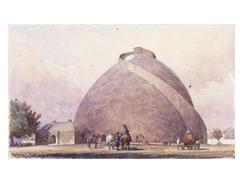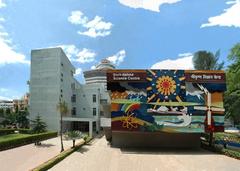Pathar Ki Masjid, Patna: Visiting Hours, Tickets, and Visitor Guide
Date: 14/06/2025
Introduction
Pathar Ki Masjid, meaning “Stone Mosque,” stands as a distinguished Mughal-era monument in the heart of Patna, Bihar. Constructed in 1621 CE by Prince Parwez Shah, son of Emperor Jahangir, this historic mosque is a testimony to the Mughal Empire’s architectural brilliance and its enduring spiritual and cultural influence. Overlooking the Ganga River and situated close to other religious landmarks, Pathar Ki Masjid is not only a center for Islamic worship but also a symbol of Patna’s pluralistic and vibrant heritage. This comprehensive guide provides historical insights, visitor information, architectural highlights, and practical tips to ensure a meaningful experience at one of Patna’s most iconic landmarks.
Table of Contents
- Historical Background
- Religious and Cultural Significance
- Architectural Overview
- Visitor Information
- Travel Tips and Nearby Attractions
- Frequently Asked Questions (FAQs)
- Summary and How to Plan Your Visit
- References
Historical Background
Origins and Patronage
Pathar Ki Masjid was commissioned in 1621 CE by Prince Parwez Shah, the second son of Mughal Emperor Jahangir, during his tenure as the governor of Bihar. The mosque’s construction coincided with the Mughal strategy of consolidating power in eastern India, using monumental religious architecture to establish their authority and promote religious harmony (Bharat Stories; Prepp.in). Its riverside location symbolized both spiritual significance and political presence.
Architectural Features and Materials
Unlike most regional mosques built from brick and stucco, Pathar Ki Masjid is constructed entirely from grey stone blocks—a rarity at the time. This material choice ensures the mosque’s remarkable durability and gives it a distinctive aesthetic. The structure features a modest central dome flanked by smaller domes and minarets, with arched entrances and carved pillars that reflect the syncretic Indo-Islamic style (Bharat Stories; The Islamic Heritage).
Mughal Influence and Historical Context
Patna’s emergence as an administrative and commercial hub under Mughal rule is reflected in the mosque’s grandeur. The construction of Pathar Ki Masjid embodied the Mughal ethos of integrating imperial power with local traditions and fostering religious pluralism. The mosque’s understated elegance and use of stone influenced later religious and civic architecture in the region (MapsofIndia).
Names and Local Significance
The mosque is also referred to as Saif Khan’s Mosque, Sangi Masjid, and Chimni Ghat Mosque, names derived from local traditions and historical associations. It remains an active center of worship, especially vibrant during Friday prayers and Islamic festivals, and serves as a focal point for Patna’s Muslim community (Bharat Stories).
Preservation Efforts and Challenges
Rapid urban development has presented challenges in maintaining the mosque’s visibility and integrity, as surrounding markets and buildings often obscure it from view. Nevertheless, local authorities and heritage organizations undertake periodic restoration and maintenance. Community engagement also plays a crucial role in preserving the mosque’s legacy (Bharat Stories).
Religious and Cultural Significance
Center for Worship
Pathar Ki Masjid is a vital spiritual center where daily prayers and major Islamic festivals such as Eid al-Fitr and Eid al-Adha are celebrated. Large congregations gather here, especially during significant religious occasions, underscoring the mosque’s central role in the community (MapsofIndia).
Festivals and Community Life
During Islamic festivals, the mosque and its surroundings are decorated with lights and banners, creating a festive and unified atmosphere. In addition to worship, the mosque has historically hosted social gatherings and charitable activities, such as distributing food to the needy during Ramadan.
Symbol of Plural Heritage
Pathar Ki Masjid exemplifies Patna’s pluralistic traditions by standing alongside other major religious sites, including Har Mandir Sahib (a Sikh gurdwara) and several Hindu temples. Its enduring presence for over four centuries testifies to the city’s culture of coexistence (NativePlanet).
Architectural Overview
Construction Materials and Design
The mosque’s robust stone construction is rare for the region and period. Every architectural element, from walls and pillars to domes and minarets, is crafted from carefully hewn stone blocks. This not only ensures longevity but also creates a cool, serene environment within the mosque (The Islamic Heritage; cuetmock.com).
Domes, Minarets, and Carvings
Pathar Ki Masjid features three domes, the central one being larger and more ornate, flanked by smaller domes and modest minarets. The minarets, while not very tall, offer panoramic views of the cityscape. The mosque’s façade and pillars are embellished with geometric Islamic patterns, floral motifs, and Quranic inscriptions, reflecting both Islamic and indigenous artistic traditions (The Islamic Heritage; tourtravelworld.com).
Spatial Layout and Orientation
Located on the banks of the Ganges near Ashok Rajpath, the mosque is oriented westward towards Mecca. The spatial arrangement consists of a central prayer hall supported by intricately carved stone pillars, an open stone-paved courtyard for large gatherings, and a modest gateway leading into the tranquil complex (wikipedia).
Visitor Information
Location and Accessibility
- Address: Patthar ki masjid, Tripolia, Patna, Bihar 800006, India
- Nearest Rail: Gulzarbagh railway station (1.17 km away)
- Transport: Easily accessible by auto-rickshaw, taxi, city bus, and ride-sharing apps. The Patthar Ki Masjid Bus Stop is nearby (yappe.in).
Parking: Limited and can be congested, especially in the evenings. Wheelchair-accessible parking and entrances are available.
Visiting Hours and Entry
- Usual Hours: 6:00 AM to 8:00 PM daily (some sources note 7:00 AM or 9:00 AM opening; check locally or online for updates)
- Entry Fee: Free for all visitors; donations are welcome (yappe.in)
Facilities and Amenities
- Drinking Water: Available on-site
- Restrooms: Public facilities are available in the adjacent market area
- Shops/Eateries: The surrounding market offers snacks and local delicacies, including New Zaika Food and Ganga Sweets
Dress Code and Etiquette
- Dress Modestly: Shoulders, arms, and knees covered; women should cover their heads in the prayer hall
- Shoes: Remove before entering; wear footwear that is easy to take off
- Behavior: Maintain silence, especially during prayers; photography may be restricted inside—seek permission before photographing worshippers or interiors
Safety and Security
- Security Presence: Local police and mosque staff ensure visitor safety, with increased measures during festivals
- Personal Belongings: Keep valuables secure and cooperate with security staff
Travel Tips and Nearby Attractions
Best Time to Visit
- Early mornings or late afternoons are ideal for a peaceful experience and optimal photography
- Festivals such as Eid provide a vibrant cultural atmosphere, but expect large crowds and restricted access to some areas
Nearby Attractions
- Takht Shri Harmandir Sahib: Major Sikh pilgrimage site within walking distance
- Gandhi Ghat: Renowned for evening aarti and river cruises
- Patna Museum: Rich collections of regional history and archaeology
- Golghar: Historic granary with panoramic city views
- Har Mandir Sahib: A significant Sikh gurdwara nearby (beautyofindia.in)
Frequently Asked Questions (FAQs)
Q: What are the Pathar Ki Masjid visiting hours?
A: Typically 6:00 AM to 8:00 PM daily; verify locally for festival or maintenance changes.
Q: Is there an entry fee or ticket required?
A: No, entry is free.
Q: Are guided tours available?
A: No official tours, but local guides can be hired; check with heritage walk operators.
Q: Is Pathar Ki Masjid wheelchair accessible?
A: Yes, with wheelchair-accessible parking and entrances, though some areas may have uneven surfaces.
Q: Can I take photographs inside?
A: Photography is generally permitted, but restrictions apply during prayers; always seek permission.
Q: What is the best time to visit?
A: Early mornings or late afternoons for tranquility and best lighting.
Summary and How to Plan Your Visit
Pathar Ki Masjid remains a living testament to Patna’s Islamic legacy, Mughal architecture, and cultural pluralism. Its solid stone construction and intricate carvings evoke centuries of history, while its ongoing role as a community hub makes every visit a blend of the past and present. Early morning visits offer serene ambiance and photographic opportunities, while festival days allow immersion in vibrant local traditions.
Tips for a Memorable Visit:
- Confirm visiting hours before your trip.
- Dress modestly and respect all customs.
- Arrive early to avoid crowds and enjoy the peaceful atmosphere.
- Explore nearby Patna landmarks for a fuller cultural experience.
- Download the Audiala app for up-to-date travel information and follow related social media channels for the latest updates.
Pathar Ki Masjid is more than just a monument—it’s a gateway to Patna’s enduring heritage and a window into its pluralistic soul.
References
- Bharat Stories
- MapsofIndia
- The Islamic Heritage
- Yappe.in
- NativePlanet
- Wikipedia
- cuetmock.com
- tourtravelworld.com
- beautyofindia.in
- meraapnabihar.com
- Prepp.in




